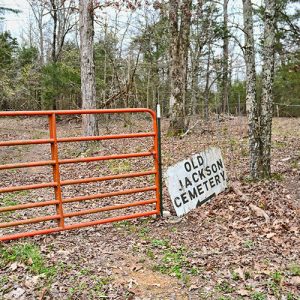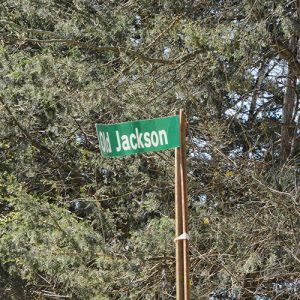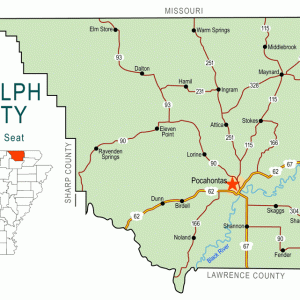calsfoundation@cals.org
Old Jackson (Randolph County)
Jackson was a town once located in Lawrence County, approximately two miles northeast of the current town of Imboden (Lawrence County) and several miles west of the Eleven Point River. The town was centered on the Old Jackson and Union roads. Jackson, one of the few towns located on the Southwest Trail, served as the county seat for Lawrence County from 1829 to 1837. It was also an important location on the Trail of Tears due to its placement along the Fort Smith to Jackson Road. After boundaries were redefined in 1861, the town was located in Randolph County. By the 1880s, little was left of the town, which had become known as Old Jackson.
Many sources show 1830 or 1832 as the date for the post office’s establishment, although it was likely August 1829, when the county courts were relocated from the first county seat, Davidsonville (Lawrence County), to Jackson. In 1823, Henry Schoolcraft passed through Jackson on the Southwest Trail, headed north toward Missouri, though he made no mention of the town. In 1829, after the first county seat failed, Lawrence County officials chose Jackson to replace Davidsonville. In summer 1829, the county commissioned a road to Jackson by way of DeMunn’s Mill—now Pocahontas (Randolph County). It may be that this road assisted Davidsonville merchants in dismantling their buildings and moving them to Jackson. A house in Jackson was used as a courthouse.
From 1833 to 1843, John S. Ficklin, a speculator from Kentucky, was the Jackson postmaster. Thomas H. Ficklin, likely a relative of John Ficklin, established a mercantile business in 1835; it is probable that the post office was located in Ficklin’s store. Colonel Robert Smith, a successful businessman from Davidsonville, opened a tavern in 1829. Thomas Black, a relative of Eli Black who operated Black’s Ferry over the Eleven Point River, opened the Jackson Hotel in 1831. Dr. Henderson White was the town physician. Attorney William B. Harness established a law office in Jackson, and a former justice of the peace from Davidsonville, Beverly Baker, established a mercantile in 1831 named Ringgold and Redman. There were probably other businesses in Jackson at the time.
In 1830, Congress proposed a federal road from Washington (Hempstead County) to Jackson. The road would be an improvement on the well-used Native American route passing through Jackson and heavily used by those traveling to and through Arkansas Territory. Funding was approved to improve the remainder of the route from Jackson to the Missouri state line.
The Spring River (Baptist) Church, just outside Jackson, may have been the only church in the area. The congregation was active until a few years after the Civil War.
In August 1831, a call for bids was published for the road from Washington to Jackson. Among details mentioned was the Spring River ferry in operation near Jackson. The Southwest Trail was not the only road proposed to pass through Jackson: tavern owner Robert Smith, who had become a member of the Territorial House of Representatives from Jackson, proposed a road from Memphis, Tennessee, through Jackson to Fayetteville (Washington County) in 1831.
In October 1831, the territorial legislature levied a tax on Lawrence County for the purpose of building a county jail in Jackson. In December 1831, the only known court-ordered hanging occurred in Jackson. Polly Hillhouse near the Strawberry (Lawrence County) settlement was murdered by “a negro boy named Jarrett.” Jarrett fled to Missouri and was captured, jailed in Jackson, convicted, and executed on the “hanging tree” in Jackson the same month. The infamous hanging tree was a large white oak on the south side of Union Road, approximately 200 yards northeast of the center of town. The tree was a town landmark; it died in the early 1990s.
In January 1834, the Arkansas Stage Line began operation; the public notice was posted from Jackson. It is uncertain how long the stage line was in operation, but it operated from Little Rock (Pulaski County) to Hix’s Ferry on the Southwest Trail, and on to the Bainbridge ferry near Jackson, Missouri. There was a station at Columbia (Randolph County), also known as Fourche de Toma, where teams were stabled and passengers could rest.
In late fall 1834, George William Featherstonhaugh and his son passed through Jackson on their way south. He observed the following after crossing the Eleven Point River: “The country from hence was rough, and hilly for six miles to Jackson, a wretched place which passes for the county town, and which is situated—why I know not—at the inconvenient distance of a mile from a beautiful transparent stream called Spring River.”
In May 1833, Territorial Governor John Pope passed through Jackson on his way to visit Kentucky. In October 1833, Thomas Bruce of Lawrence County was murdered by William P. Rice. Rice was apprehended and returned to Jackson and indicted. However, Rice did not go to trial because Judge Thomas P. Eskridge released him.
In July 1835, a meeting was held in Jackson for the express purpose of quickening the pace of bringing Arkansas into the union. Thomas S. Drew, who was later elected governor of the state of Arkansas, chaired the meeting. In the fall of 1835, the territorial legislature proposed another new road from St. Francis County to end in Jackson.
In fall 1835, Randolph County was formed, and Jackson was now on the eastern border of Lawrence County. A few days after Randolph County’s formation, the territorial legislative council voted to move the county seat from Jackson to a more central location. The next month, Robert Smith, who had become a member of the Arkansas Territorial Senate, presented a letter from citizens of Lawrence County protesting the removal of the county seat from Jackson. Soon after, angry charges appeared in the newspapers, charging Smith of buying off the commissioners selecting the new county seat so the new town would be named for Smith. The new county seat, Smithville, was established in 1837.
After the founding of Pocahontas and Smithville, Jackson was rarely mentioned in newspapers for other than proposed postal routes originating in or passing through the town. A new mercantile was licensed by Major Elijah S. Inge in 1838; Inge may have purchased Thomas Ficklin’s store after Ficklin died from cholera in 1835.
In December 1838, the Benge Detachment of the Trail of Tears passed through Jackson. The detachment entered Arkansas on December 8 and passed through Jackson on December 10 or 11. There were reports of measles and whooping cough in the party, with an average of four Native Americans perishing daily. Local tradition holds the Native Americans encamped along a creek south and east of Jackson, and several dead were buried along the creek bed. Another tradition holds that Ringgold and Redman mercantile supplied materials to the Cherokee camped at Smithville for the winter of 1838–39 but was never reimbursed and consequently fell into bankruptcy.
The History of the Arkansas Press for a Hundred Years and More contains the claim that Jackson had a short-lived newspaper, The Defender. The story goes that a printer, with a small press in his wagon, followed the Native Americans on their journey to Arkansas. He was tired of traveling and stopped in Jackson. The account is questionable because the dates do not match the dates for the Benge Detachment. No copies of The Defender have been found.
Jackson was by all accounts a rough little town. In Folklore of Romantic Arkansas, the town was said to have had several hand-hewn-log saloons. Saturdays were especially rowdy, as young men from Janes Creek and Eleven Point (Randolph County) met in Jackson. One of the saloon keepers had a “spirited” steer, and he said that any man from Eleven Point who could not ride the bull unharnessed would not be served. In spring 1849, James Marshall was shot by a man named William Berry. The trial was held in Smithville. The next year, Jackson experienced another murder when a Kentucky man stopped in Jackson on his way back from a trading tour to Texas; he consumed too much alcohol and passed out. Two Jackson men, James Minor and Samuel McGehee, took turns attacking the man. The victim was dragged into the woods and left for dead, and Minor and McGehee took the victim’s horse and saddlebags and tried to escape. However, the man recovered sufficiently to cry for help, and the two attackers were captured. The men present quickly lined up as many of the town’s men as possible, placing the prisoners in among the citizens; they all passed in front of the dying victim, who easily pointed out his two assailants. Minor and McGehee confessed their guilt and were tried, convicted, and hanged at Smithville.
The 1860 census provides possibly the only illustration of Jackson available and is the only census listing Jackson Post Office. In September 1860, there were 469 white people (no slaves) living near Jackson Post Office: 244 males and 225 females. At least seventy percent had been born in Arkansas or Tennessee, and the residents included doctors, merchants, and blacksmiths, as well as one minister. By the census of 1870, less than half that number remained—all farmers, except for one postmaster and one school teacher.
Arkansas Act 133 of 1861 redefined the borders of Randolph County so that Jackson was in Randolph County.
The Songer family lived in Jackson for many years, into the twentieth century. Jacob Sherman Songer operated the Spring River ferry after 1865 and was also a blacksmith. One member of the family cooked for the prisoners in the city jail. In 1870, one was the postmaster; his daughter taught school. Many of those buried in the Old Jackson cemetery are Songer family members. In 1978, two years before his death, Paul Songer drew the only known map of Jackson.
Locals eventually began referring to the town as Old Jackson. In 1882, the Old Jackson School District was formed from several other area school districts, and the district was abolished in 1917. In 1884, the post office in Jackson was closed. Almost no other mention was made of the town until Goodspeed’s history of the area noted in 1889: “Nothing remains of Old Jackson.” That same year, the town of Imboden incorporated and a bridge was built across the Spring River.
In the twenty-first century, only the steps from the old school, part of the road intersection, and the old cemetery survive from the town of Jackson.
For additional information:
McKinney, Pauline. “The Hanging Tree.” Lawrence County Historical Journal 3 (Spring 1998): 18.
Morgan, Kathy Cude (Lester). “History of Old Jackson.” Lawrence County Historical Journal 3 (Spring 1998): 14.
Mary Alice Chambers
North Little Rock, Arkansas
 Hanging Tree
Hanging Tree  Old Jackson Cemetery
Old Jackson Cemetery  Old Jackson Map
Old Jackson Map  Old Jackson Road
Old Jackson Road  Randolph County Map
Randolph County Map 



Comments
No comments on this entry yet.